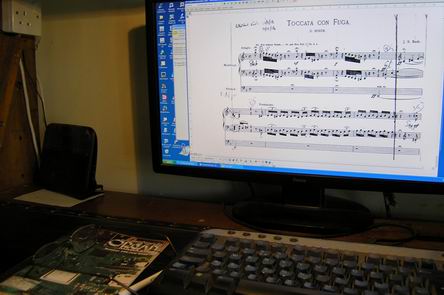
 This article was published in the Electronic Organ Magazine, 260 January 2022
This article was published in the Electronic Organ Magazine, 260 January 2022
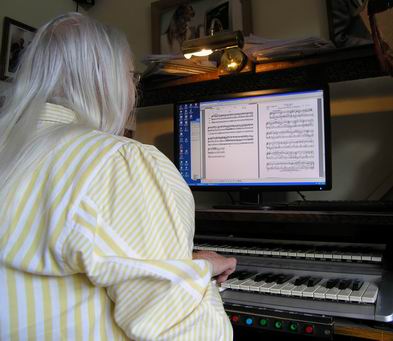
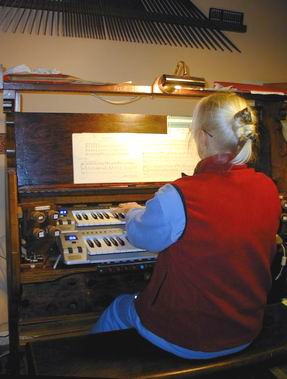
After a decade or so, I was left with a very thick loose-leaf file with a rather personal collection of my own favourite music. Its only ordering was that at the front I put pieces I was learning to play in the coming weeks and at the back I put the pieces I had just played. It all worked well with pieces moving from the front to the back with a nicely long cycle time. Pieces I hardly ever played got stuck in the middle and could be transferred to the bin.
EOCS readers may remember the Multi-media miracle article that our society kindly published in July 2008. It described my version of Colin Pykett's Prog Organ, with 2 keyboards, a pedalboard,8 drawstops and a further 20 sets of buttons.The figure from the old article shows my wife Mo playing the organ in this mode. It is a delight to report that my Prog Organ has been in constant use these last 15 years. Much is unchanged. The old XP computer has given no trouble since being disconnected from the internet: I now have a modern works laptop for such use. An important change is that the little monitor seen in the article has been updated to a 23" screen. Its height is almost that of a portrait A4 sheet and its width more than sufficient to show show two pages side by side.
As a lockdown project I thought I would tidy up my folder! I went through it all, re-copying many that contained useful information besides the notes. As an old pianist, most of my pieces were portrait A4 pages, and most usually covered around two pages. For this project all the pages went into a Microsoft word file of keyboard_favourites.

I was delighted to find that the pages were just as easy to read from the screen as they had been on my music stand. Because my organ music stand folds down to make a table-top when the screen is being used, the screen can be placed at whatever distance your eyes prefer. A good fraction of the pages were organ music with long "landscape" spreads that needed to be separate "organ_favourites" file.
The figure shows it working out in practice. The table-top is really useful at practice times, as there is plenty of room for sheet music, notebooks and the computer keyboard for editing music. Of course the table-top mostly covers the keyboards, but there is plenty of room underneath for your fingers. Seeing where your fingers are on the keyboard is a potential problem, especially with the swell, but in practice this was not a problem: organists usually end up needing all their eyes to follow the music!
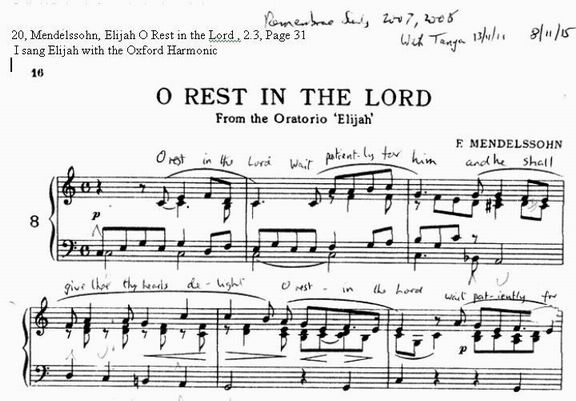
The nice aspect of the word file was that it could be so easily searched using key-words for the composer, title and page number of each piece. As the figure below shows, these details appear in a header line above each image of the music and can be searched when using word or pdf files. In the example shown the first line defines piece number 20, composer Mendelssohn, Title Elijah O Rest in the Lord, time 2.3 minutes, and page 31. Written on the page are the dates when it was played, that it was on Remembrance Sunday, and that on two occasions fine alto chorister Tanya had sung the aria. You can just see the occasional heel and toe markings for the organ pedal notes.
The document was headed with one index giving the alphabetical page number for composers and another one for titles. The actual order has stayed in the order it was made, which was a rather personal order of the pieces I had first loved, and played most. My favourite keyboard pieces ended up as 60 pieces over 100 pages and the pdf file was 17MB long.
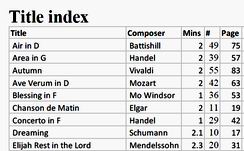
The last step is to turn the word file into the more efficient pdf file, and copy it whatever other screens you might have. Our family ipad is perfectly readable on our piano and its touch screen enables you to flick the pages over without a pause. Another file I have made of our favourite songs works well with the ipad on the piano and a smart phone for the singer. The loose-leaf file lives on with the pages in the order of the file, still suitable for taking in the haversack when at last we can!

Starting the organ up, its always a pleasure to let your fingers recall some old favourites! Stuck with just a smartphone and nothing much to do, just reading through the music and hearing in your head the sound of your favourite pieces is wonderfully comforting and rewarding. As dear old Bach might have said, "There's no need to actually play the music !". Of course he would not have needed the music score either!
Copyright 2021 Colin Windsor : Last updated 14/4/2021